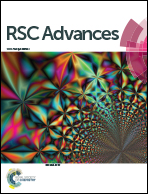Methotrexate anchored carbon dots as theranostic probes: digitonin conjugation enhances cellular uptake and cytotoxicity†
Abstract
In recent years carbon dots (CDs) have been drawing increasing attention in the area of nano medicine. Their indubitable roles in cellular imaging, drug delivery and diagnosis are widely acknowledged. Digitonin (DG) has traditionally been known as a cell membrane permeabilizing agent. Based on this fact, we modified CDs with DG (CDDG) and further conjugated them with methotrexate (MX). This probe, CDDG conjugated MX (CDMX) was subjected to physico chemical characterization, cytotoxic evaluation via MTT assay and cellular uptake studies using confocal laser microscopy. The drug release study implied that at physiological pH, release is less reflecting maximum drug retention in the probe during circulation. The results which emerged have shown that DG is impacted in enhancing cellular uptake and cytotoxic potential of the drug carriers. The study indicates that theranostic probes with improved features can be generated from CDs by a judicious modification.


 Please wait while we load your content...
Please wait while we load your content...